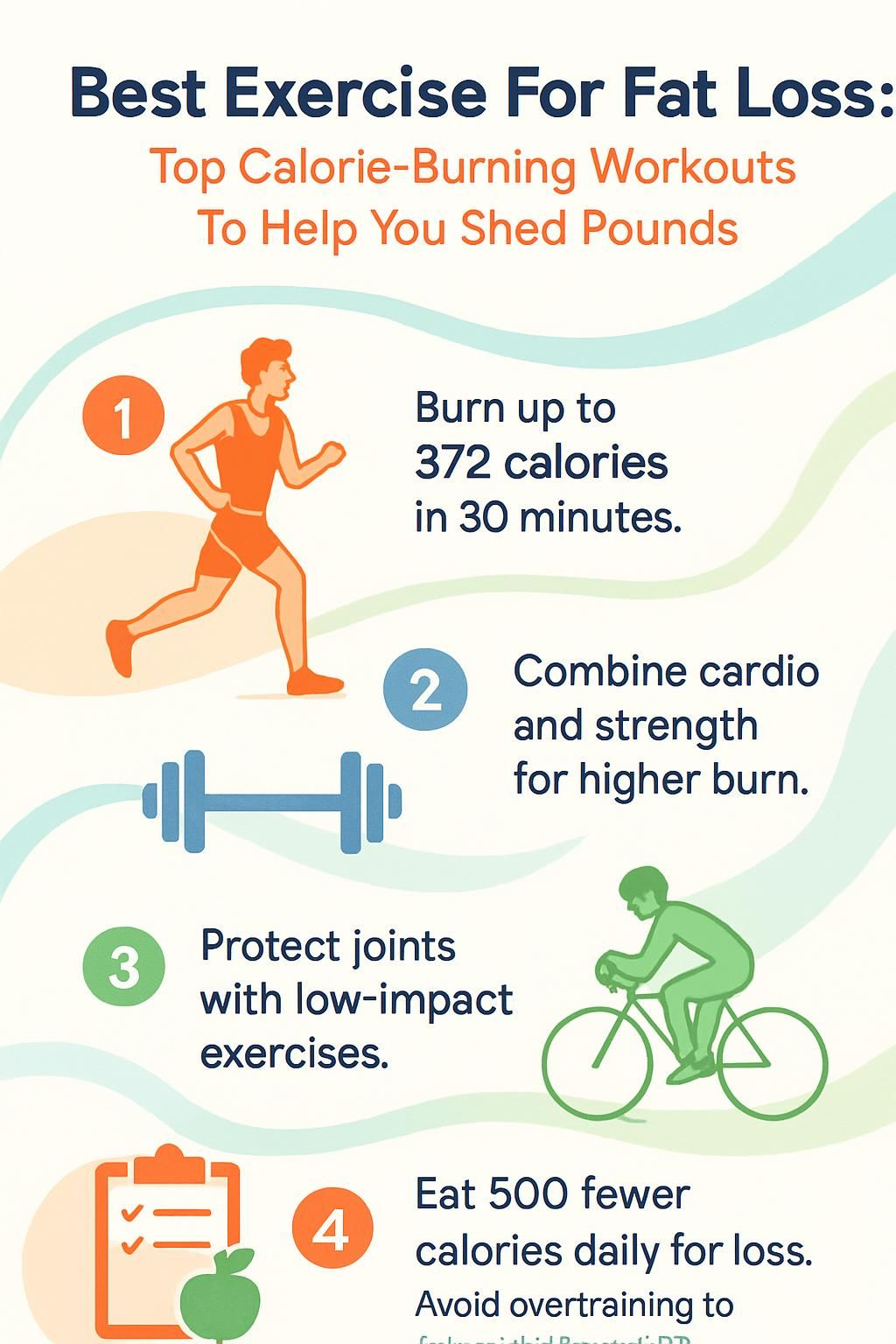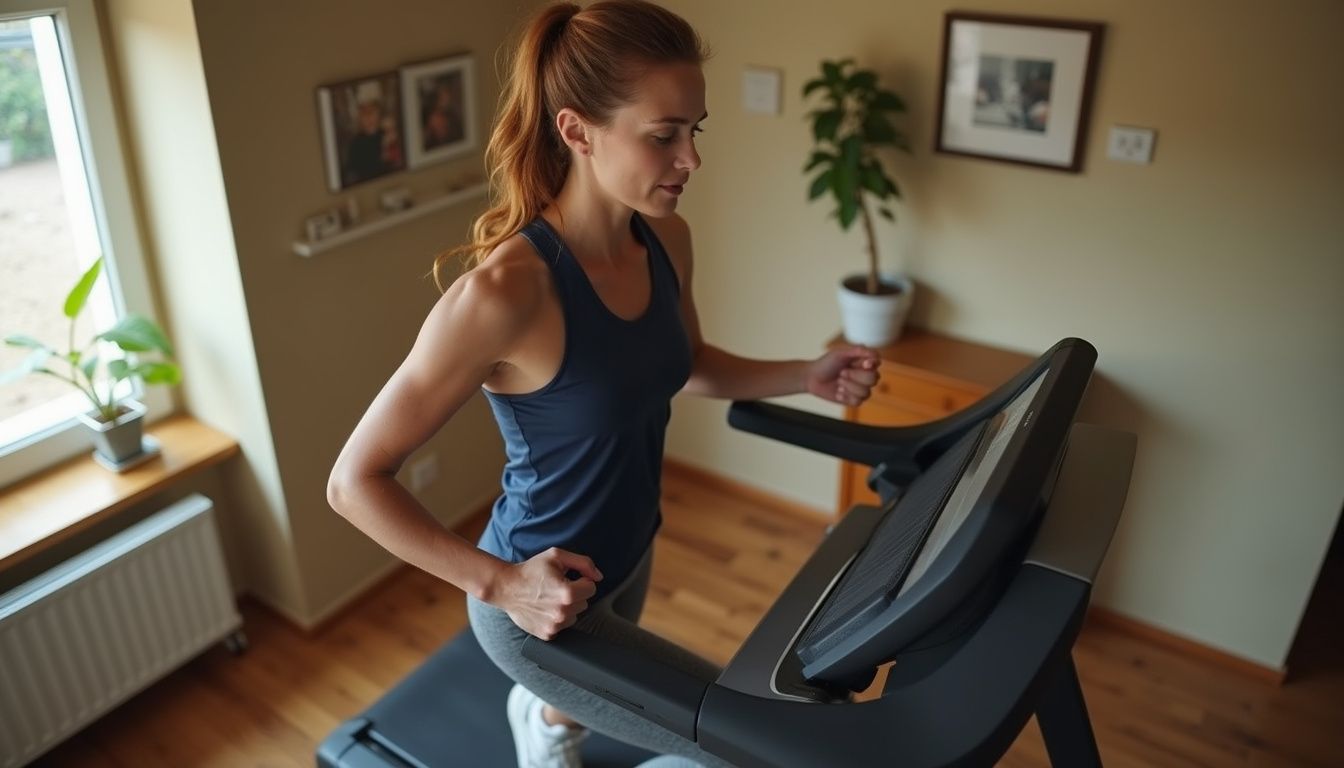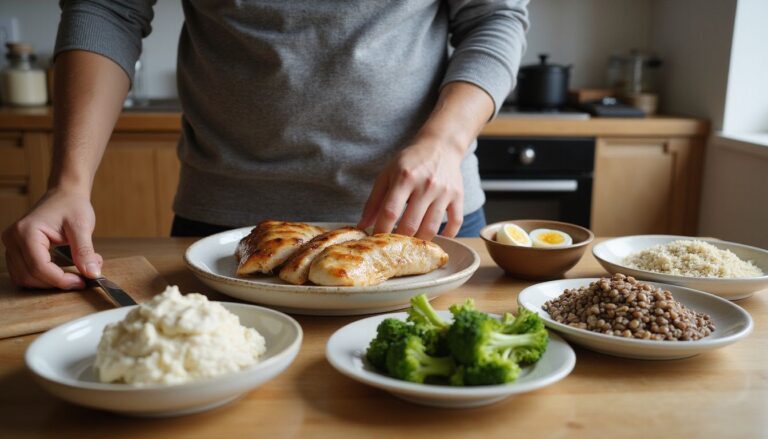Best Exercise For Fat Loss: Top Calorie-Burning Workouts To Help You Shed Pounds
Our Nutrition Assistant AI Suite will transform your body. You will lose fat, get toned, and build muscle. Gain confidence and optimal health.
You want exercise for weight loss that truly works. The right plan helps you burn calories, protect your joints, and stay consistent. Research shows high-intensity exercise can speed fat loss compared with easy, steady workouts.
This guide explains the best exercises for weight loss, how to pair them, and smart habits that help you stick with it. You will see which routines burn the most calories and how to use them safely. If you have a health condition, talk with a healthcare professional before starting a new program.
Key Takeaways
- High-intensity workouts like HIIT and running can burn up to 372 calories in 30 minutes for a 155-pound person, which supports faster fat loss (Harvard Medical School, 2021).
- Combining cardio with strength training raises calorie burn during and after workouts by building muscle and increasing resting metabolism.
- Low-impact options such as cycling, Pilates, and elliptical training protect joints while burning 175 to 750 calories per session, based on time and intensity.
- Creating a steady calorie deficit through food choices, for example 500 fewer calories per day, helps you lose about one pound per week.
- Overtraining increases injury risk, fatigue, mood changes, and low immunity. Proper rest improves recovery and supports long-term results.

Why is exercise important for fat loss?

Exercise helps you lose fat because it increases how many calories you burn each day. Cardio, which means aerobic exercise that raises your heart rate, uses stored fat for energy during longer efforts.
Strength training builds muscle. Muscle tissue burns more calories at rest compared with fat tissue, so your daily burn goes up. A 155-pound person may burn about 372 calories during a 30-minute run at six miles per hour, according to Harvard Health.
Regular activity also lowers your risk of type 2 diabetes and heart disease. It can ease stress and reduce emotional eating. A short walk before dinner, even 10 to 15 minutes, often helps curb cravings and supports steady progress.
Cardiovascular Exercises for Fat Loss
Cardio is a reliable way to burn calories and reduce body fat. These exercises use large muscle groups and keep your heart rate up, which helps the body use more energy.
How does walking help burn calories?
Walking burns calories by engaging your legs, hips, and core with each step. A brisk pace near 4 miles per hour helps a 155-pound person burn about 150 calories in 30 minutes.
Speed, distance, and hills raise calorie burn. Making daily walks part of your routine supports weight loss with low impact on joints. Research in women with a sedentary lifestyle shows that regular aerobic exercise like walking improves body composition over time.
If you aim for at least 150 minutes per week of moderate-intensity activity, walking is a simple, effective way to lose fat while staying kind to your knees and back.
Is jogging or running effective for fat loss?
Jogging and running lift your heart rate, so you burn many calories per minute. A 155-pound person can burn about 372 calories during a 30-minute run at six miles per hour.
These workouts use several muscle groups and create an afterburn effect. Afterburn, also called excess post-exercise oxygen consumption or EPOC, is the extra calorie burn that continues for hours after a tough session.
Many people track weekly miles or time, which makes progress easy to see. Setting a goal like ten miles per week can help you stay consistent.
What are the benefits of cycling for weight loss?
Cycling burns calories while staying gentle on your joints. Depending on speed and effort, you can burn roughly 400 to 750 calories per hour. You can also adjust resistance to match your fitness level.
Regular cycling can lower body mass index and improve heart health. A British Medical Journal study linked bike commuting with a lower risk of heart disease. Mixing steady pedaling with short, hard bursts works like HIIT and adds variety.
Cycling provides reliable aerobic exercise and supports healthy weight management, says Dr. Sarah Hallberg, obesity researcher.
Try one to two rides at a steady pace each week, plus one interval session with 30 to 60 second sprints. This plan keeps training fresh and challenges your lower body.
How does swimming contribute to fat burning?
Swimming trains your whole body. Water adds resistance, so your arms, legs, and core work each stroke. A 155-pound person can burn about 200 to 300 calories in 30 minutes of moderate freestyle.
Because water supports your joints, swimming works well if land-based HIIT causes aches. With a consistent plan, you can see clear changes in body composition in a few weeks.
Can stair climbing help shed pounds?
Stair climbing is a fast way to raise your heart rate and calorie burn. You may burn about 0.17 calories per step going up and 0.05 calories per step going down. For a 155-pound person, 30 minutes on stairs can reach about 223 calories.
You do not need special gear, which makes it easy to start. Choose a safe pace, then build time or floors climbed. Pair stair work with walking, running, or cycling for well-rounded conditioning.
…
1. Ainsworth BE et al., Compendium of Physical Activities, updated MET values. 2. Harvard Medical School, Calories burned in 30 minutes for people of three different weights, 2021.
High-Intensity Interval Training (HIIT)
HIIT uses short bursts of hard work followed by brief recovery. These intervals help you burn more calories in less time and can improve fitness quickly.
Advantages of incorporating HIIT workouts
HIIT sessions raise your heart rate fast, then keep metabolism elevated for hours through the afterburn effect. That extra burn helps fat loss even after you stop moving.
You can do HIIT with bodyweight moves like squats or jump rope. Sessions often last 20 to 30 minutes, which fits a busy week. Over time, HIIT can build strength, improve endurance, and make hard efforts feel easier.
What are some sample HIIT workouts for fat loss?
Use one or two sessions per week at first. Warm up for 5 minutes. Then pick a plan below.
- Sprint Intervals: Run hard for 30 seconds, walk for 90 seconds. Repeat 8 rounds.
- Jump Rope HIIT: Skip fast for 45 seconds, rest 15 seconds. Complete up to 10 rounds.
- Bodyweight Circuit: Do squats, push-ups, burpees, and mountain climbers for 40 seconds each. Rest 20 seconds between moves. Repeat the circuit 3 times.
- Bike Sprints: Pedal at high intensity for 1 minute, easy pace for 2 minutes. Do 7 rounds.
- Tabata: Choose one move, like jumping jacks or kettlebell deadlifts. Work 20 seconds, rest 10 seconds. Repeat 8 times.
- Stair HIIT: Climb fast for 1 minute, descend slowly for 2 minutes. Do 5 cycles.
- Resistance Band HIIT: Perform band rows or presses for 40 seconds, rest 15 seconds. Rotate through 4 moves for 4 rounds.
Cool down for 3 to 5 minutes. If you feel dizzy or short of breath, pause and lower the intensity next time.
Strength Training for Fat Loss
Strength training builds lean muscle, which increases resting metabolism. The result is more calories burned day and night, even when you are not exercising.
How does weightlifting aid in fat loss?
Lifting weights increases muscle mass, so your body uses extra energy at rest. Research suggests strength sessions can boost calorie burn for up to 38 hours afterward.
Depending on effort and size, a 30-minute lifting workout may burn 180 to 266 calories. As you gain muscle, your clothes fit better because muscle is dense and reshapes your body.
Two to three full-body sessions per week work well for most people. Combine that plan with a balanced diet to support steady fat loss and better body composition.
What bodyweight exercises burn the most calories?
Bodyweight moves can torch calories without equipment. They target big muscle groups and keep your heart rate up.
- Burpees combine a squat, push-up, and jump. They can burn roughly 10 to 15 calories per minute.
- Mountain Climbers challenge your core and shoulders. Expect around 8 to 11 calories per minute.
- Jumping Jacks deliver full-body cardio. Many people hit 8 to 12 calories per minute.
- Push-ups build chest, shoulders, and core. Longer sets increase total burn.
- High Knees raise intensity quickly and train hip flexors, glutes, and abs.
- Plank Jacks train core stability with a cardio kick.
- Walking Lunges strengthen legs and hips while improving balance.
- Squat Jumps add power and speed to leg training.
- Triceps Dips work the back of your arms and require core control.
String 3 to 5 of these into a short circuit. Work for 30 to 45 seconds, then rest for 15 to 30 seconds. Repeat for 3 rounds.
How do resistance band workouts support fat loss?
Resistance bands add tension through the whole range of motion. This extra challenge increases energy use and helps build muscle with less joint stress.
Bands also raise heart rate when you move at a steady tempo. Try a simple full-body set, such as band squats, rows, chest presses, and core twists. As form improves, switch to thicker bands or add reps.
Low-Impact Workouts for Fat Loss
Low-impact routines protect your joints while still burning meaningful calories. Think of these as smooth ways to stay active on tough weeks.
Can yoga help with fat loss?
Yoga can support fat loss by building body awareness and promoting mindful eating. A 2016 study reported reductions in body weight and waist size after 12 weeks of regular practice.
Flow styles like Vinyasa keep you moving and increase calorie burn. Challenging poses work multiple muscle groups and raise your heart rate moderately. Yoga also reduces stress, which may help control cravings.
How does Pilates contribute to calorie burning?
Pilates uses controlled movements and breathing to target many muscles at once. A 150-pound person may burn about 175 to 250 calories in a moderate 60-minute class, according to the American Council on Exercise.
Beyond calories, Pilates improves core strength, posture, and muscle tone. With regular practice, many people see a flatter midsection and better balance during daily tasks.
Is elliptical training effective for weight loss?
The elliptical burns calories while staying easy on knees and hips. Many people burn 270 to 400 calories in 30 minutes, based on body size and intensity. Using the handles works both upper and lower body, which boosts total burn.
Consider varying resistance and speed to avoid plateaus. Swapping one treadmill session for an elliptical workout each week can give your joints a break while keeping progress going.
…
Source: American Council on Exercise, Calorie Burners: Activities That Turn Up the Heat, acefitness.org, accessed March 2024.
Outdoor Activities for Fat Loss
Training outside can make exercise feel less like a chore. Fresh air and changing views help many people stay consistent.
How does hiking promote fat loss?
Hiking engages your legs and core while elevating your heart rate. At a moderate 3.5 miles per hour on varied terrain, you might burn 430 to 480 calories per hour.
Hills add intensity and keep your heart rate higher. A backpack increases the challenge. Uneven ground forces small stabilizer muscles to work, which raises total energy use.
Choose marked trails and bring water and a snack. Short weekday hikes build stamina for longer weekend routes.
What are the fat-burning benefits of rowing?
Rowing trains your legs, back, and core in one fluid motion. Many people burn 400 to 600 calories per hour based on pace and body weight.
Intervals on the rower, like 1 minute hard then 2 minutes easy, increase afterburn. This helps you continue to burn calories after you finish.
Can jumping rope help you lose weight?
Jumping rope is compact, cheap, and effective. A 155-pound person can burn about 372 calories in 30 minutes at a moderate pace. It also improves coordination and footwork.
Start with 30 to 60 second sets. Rest briefly, then repeat. Mix with bodyweight moves or add it to a HIIT day.
Tips for Maximizing Calorie Burn During Workouts
Small training tweaks can increase results. A few habit shifts make each session count.
How often should you exercise for fat loss?
Aim for at least 150 minutes per week of moderate activity like brisk walking or cycling. Spread this across most days, for example 30 minutes on five days.
For faster change, work up to 300 minutes per week or add vigorous sessions like running or HIIT. Include strength training for all major muscle groups at least twice per week.
Consistency is key. A mixed plan keeps boredom low and covers more fitness needs.
Why combine cardio and strength training?
Pairing cardio with strength training gives you the best of both. Cardio helps you burn many calories during the workout. Strength training builds muscle so you burn more calories around the clock.
Alternate days or stack a short lift after a cardio warm-up. This approach reflects the best exercises for weight loss because it protects muscle while reducing fat.
What are active rest days and why use them?
Active rest days help you recover without going back to the couch. Light movement boosts blood flow and reduces soreness.
Good choices include easy walks, gentle yoga, or relaxed cycling. Active rest supports long-term progress and lowers injury risk so you can train hard again later in the week.
How Diet Complements Exercise for Fat Loss
Training hard cannot outwork a high-calorie diet. Food choices create the steady calorie deficit that helps you lose fat while keeping energy up for workouts.
Why is a calorie deficit essential for weight loss?
Your body needs to use more energy than it takes in to lose weight. Cutting about 500 calories per day can lead to roughly one pound of fat loss per week since one pound equals about 3,500 calories.
Tracking meals, measuring portions, and choosing nutrient-dense foods make a deficit easier to hold. Pair this with regular activity for steady results.
What nutrient-dense foods provide energy for workouts?
Choose foods that fuel you without excess calories. Complex carbs give steady energy. Lean protein repairs muscles. Healthy fats support hormones and help you feel full.
Before a HIIT session, a bowl of oatmeal with peanut butter and berries can power your training from start to finish.
| Food | Carbohydrates (g) | Protein (g) | Healthy Fats (g) |
|---|---|---|---|
| Oatmeal, 1 cup cooked | 27 | 6 | 3 |
| Banana, medium | 27 | 1 | 0 |
| Chicken breast, 3 oz | 0 | 31 | 3 |
| Avocado, 1/2 fruit | 6 | 2 | 15 |
These foods can boost stamina for cardio and speed recovery after strength training or HIIT.
Choosing the Best Exercise for Your Fitness Level
A plan that suits your body and schedule is the one you can keep. Fit the workout to your life, not the other way around.
How to assess your personal exercise preferences?
Think about workouts you enjoyed in the past. Decide if you like groups or solo sessions, indoors or outdoors, steady cardio or intervals.
Note any injuries or limits. If running causes knee pain, try cycling or swimming. Keep a short journal for one week to rate enjoyment and effort. Patterns will guide your choices.
Why start slow and progress gradually?
Your muscles, joints, and tendons need time to adapt. Rapid jumps in volume or load increase the chance of strains or sprains.
Set small milestones, like two walks and one strength session this week. Add time or intensity only after your body handles the current level well. Next, watch out for common mistakes many people make during fat loss workouts.
Common Mistakes to Avoid During Fat Loss Workouts
A few errors can stall progress. Avoid these and you will move forward faster.
What are the risks of overtraining?
Training too hard too often raises injury risk and drains energy. Signs include constant soreness, poor sleep, lower motivation, and more frequent colds.
Taking rest days improves performance and mood. If you feel worn down, reduce volume for a week and focus on sleep and nutrition.
Summary table:
| Potential Risk | Description |
|---|---|
| Injury | Muscle strains and joint pain |
| Fatigue | Ongoing tiredness that lingers |
| Mood Changes | Irritability or low mood |
| Weak Immunity | More frequent illnesses |
Planned recovery keeps you healthy and supports long-term fat loss.
Why is recovery important for fat loss?
Recovery lets muscles repair and grow, which raises metabolism. Skipping rest can raise stress hormones like cortisol and slow fat loss.
Use at least one full rest day each week. Aim for 7 to 9 hours of sleep most nights. Gentle movement, mobility work, and hydration help reduce soreness so you can train well tomorrow.
Benefits Beyond Fat Loss
Exercise shapes more than your waistline. It lifts your heart, muscles, and mind.
How does fat loss improve heart health?
Lower body fat reduces strain on your heart and can improve cholesterol numbers. Even a 5 percent weight loss may help lower LDL cholesterol and blood pressure.
Consistent cardio like walking or cycling, paired with strength training, supports heart health while you lose fat.
Can exercise increase muscle tone?
Yes. Strength work, HIIT, and Pilates build and define major muscles. People who lift at least twice per week tend to gain more visible tone than those who do not.
Getting enough protein helps muscles repair and grow. More lean mass also increases daily calorie burn.
What mental health benefits come from working out?
Exercise sparks endorphins and serotonin, which can ease stress and anxiety. Even a brisk daily walk can improve mood and focus.
Activity often improves sleep quality too. Better rest supports mental health and gives you energy for the next workout.
Conclusion
Finding the best exercises for weight loss means matching training to your goals and lifestyle. Use a simple mix of cardio, HIIT, and strength training, then back it up with a steady calorie deficit. Stay consistent, progress gradually, and protect your recovery. This approach helps you burn calories, lose fat, and feel stronger week by week.
FAQs
1. What are the best exercises for fat loss and high calorie burn?
High-intensity interval training, cycling, swimming, running, and brisk walking rank among the top workouts for burning calories and promoting fat loss. Studies show that these activities increase heart rate and energy use during exercise.
2. How many calories can I expect to burn with different workouts?
Calorie burn depends on body weight, workout intensity, and duration. For example:
– Running at 6 mph: about 660 calories per hour (for a person weighing 155 pounds)
– Cycling at moderate speed: about 520 calories per hour
– Swimming laps: around 500 calories per hour
These numbers come from data published by Harvard Medical School.
3. Is strength training effective for losing fat compared to cardio?
Strength training builds muscle mass which raises resting metabolism; this helps your body burn more calories even when not exercising. Research supports combining resistance work with aerobic activity for greater overall fat reduction than using either method alone.
4. Can personal experience help in choosing the right workout for shedding pounds?
Personal preference plays a key role in sticking to an exercise plan long term. For instance, after trying several routines myself, I found that alternating between cycling sessions and circuit classes kept me motivated while supporting steady weight loss progress.
Summary: High-calorie-burning workouts like running or swimming support fat loss goals effectively according to research data. Combining strength training with cardio yields better results over time due to increased muscle mass boosting metabolism rates even outside of gym hours. Personal enjoyment influences consistency; finding enjoyable activities improves adherence and success rates in any fitness journey.







